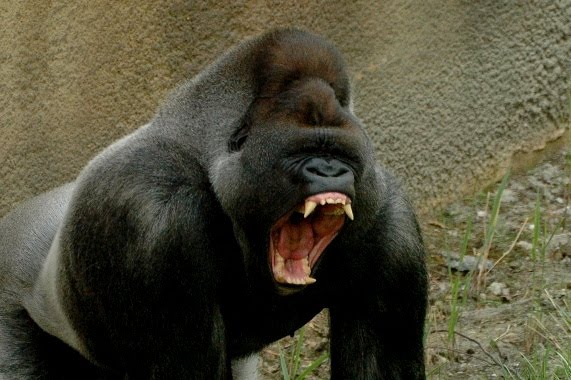

The descent of Evolution
A. The nature of the Ape. According to the Online Etymology Dictionary, the word "monkey" may originate in a German version of the Reynard the Fox fable, published circa 1580. In this version of the fable, a character named Moneke is the son of Martin the Ape.[1] In English, no very clear distinction was originally made between "ape" and "monkey"; thus the 1910 Encyclopædia Britannica entry for "ape" notes that it is either a synonym for "monkey" or is used to mean a tailless humanlike primate.[2] Such ambiguities persist. Colloquially, the terms "monkeys" and "apes" may still be used interchangeably.[3] Also, a few monkey species have the word "ape" in their common name, such as the Barbary ape. Later in the first half of the 20th century, the idea developed that there were trends in primate evolution and that the living members of the order could be arranged in a series, leading through "monkeys" and "apes" to humans.[4] Monkeys thus constituted a "grade" on the path to humans and were distinguished from "apes". Scientific classifications are now more often based on monophyletic groups, that is groups consisting of all the descendants of a common ancestor. The New World monkeys and the Old World monkeys are each monophyletic groups, but their combination is not, since it excludes hominoids (apes and humans). Thus the term "monkey" no longer refers to a recognized scientific taxon. The smallest accepted taxon which contains all the monkeys is the infraorder Simiiformes, or simians. However this also contains the hominoids (apes and humans), so that monkeys are, in terms of currently recognized taxa, non-hominoid simians. A group of monkeys may be commonly referred to as a tribe or a troop.[5] wikipedia Monkey "Ape", from Old English apa, is possibly an onomatopoetic imitation of animal chatter. The term has a history of rather imprecise usage. Its earliest meaning was a tailless (and therefore exceptionally human-like) non-human primate.[7] The original usage of "ape" in English might have referred to the baboon, an Old World monkey.[citation needed] Two tailless species of macaque have common names including "ape": the Barbary ape of North Africa (introduced into Gibraltar), Macaca sylvanus, and the Sulawesi black ape or Celebes crested macaque, M. nigra. As zoological knowledge developed, it became clear that taillessness occurred in a number of different and otherwise unrelated species. The term "ape" was then used in two different senses, as shown in the 1910 Encyclopædia Britannica entry. Either "ape" was still used for a tailless humanlike primate or it became a synonym for "monkey".[7] Sir Wilfrid Le Gros Clark was one of the primatologists who developed the idea that there were "trends" in primate evolution and that the living members of the order could be arranged in a series, leading through "monkeys" and "apes" to humans. Within this tradition, "ape" refers to all the members of the superfamily Hominoidea, except humans.[3] Thus "apes" are a paraphyletic group, meaning that although all the species of apes descend from a common ancestor, the group does not include all the descendants of that ancestor, because humans are excluded.[9]
Wikipedia Ape
I think what is most shocking is how little history is brought up about these human like creatures! History has little connection between men and primates. This is problematic, because it means that the evolutionary theory of man is not based upon observation. "As of 2006, there are eight extant genera of hominoids. They are the four genera in the family Hominidae (Homo – humans, Pan – chimpanzees and bonobos, Gorilla, and Pongo – orangutans), and the four genera in the family Hylobatidae or gibbons (Hylobates, Hoolock, Nomascus and Symphalangus).[1] (The genus for the hoolock gibbons was recently changed from Bunopithecus to Hoolock.[15]) In 1758, Carolus Linnaeus, relying on second- or third-hand accounts, placed a second species in Homo along with H. sapiens: Homo troglodytes ("cave-dwelling man"). It is not clear to which animal this name refers, as Linnaeus had no specimen to refer to, hence no precise description. Linnaeus named the orangutan Simia satyrus ("satyr monkey"). He placed the three genera Homo, Simia and Lemur in the order of Primates. The troglodytes name was used for the chimpanzee by Blumenbach in 1775 but moved to the genus Simia. The orangutan was moved to the genus Pongo in 1799 by Lacépède. Linnaeus's inclusion of humans in the primates with monkeys and apes was troubling for people who denied a close relationship between humans and the rest of the animal kingdom. Linnaeus's Lutheran archbishop had accused him of "impiety." In a letter to Johann Georg Gmelin dated 25 February 1747, Linnaeus wrote: It is not pleasing to me that I must place humans among the primates, but man is intimately familiar with himself. Let's not quibble over words. It will be the same to me whatever name is applied. But I desperately seek from you and from the whole world a general difference between men and simians from the principles of Natural History. I certainly know of none. If only someone might tell me one! If I called man a simian or vice versa I would bring together all the theologians against me. Perhaps I ought to, in accordance with the law of Natural History.[16] Accordingly, Johann Friedrich Blumenbach in the first edition of his Manual of Natural History (1779), proposed that the primates be divided into the Quadrumana (four-handed, i.e. apes and monkeys) and Bimana (two-handed, i.e. humans). This distinction was taken up by other naturalists, most notably Georges Cuvier. Some elevated the distinction to the level of order. However, the many affinities between humans and other primates — and especially the "great apes" — made it clear that the distinction made no scientific sense. Charles Darwin wrote, in The Descent of Man: The greater number of naturalists who have taken into consideration the whole structure of man, including his mental faculties, have followed Blumenbach and Cuvier, and have placed man in a separate Order, under the title of the Bimana, and therefore on an equality with the orders of the Quadrumana, Carnivora, etc. Recently many of our best naturalists have recurred to the view first propounded by Linnaeus, so remarkable for his sagacity, and have placed man in the same Order with the Quadrumana, under the title of the Primates. The justice of this conclusion will be admitted: for in the first place, we must bear in mind the comparative insignificance for classification of the great development of the brain in man, and that the strongly marked differences between the skulls of man and the Quadrumana (lately insisted upon by Bischoff, Aeby, and others) apparently follow from their differently developed brains. In the second place, we must remember that nearly all the other and more important differences between man and the Quadrumana are manifestly adaptive in their nature, and relate chiefly to the erect position of man; such as the structure of his hand, foot, and pelvis, the curvature of his spine, and the position of his head.[17]" Wikipedia Ape This is the key issue in evolution. It is a comparison of species and a presupposition of evolution. Evolution is simply the assumption of a history of whatever is alike. One time man is a primate, then another time He is not. It is a subjective opinion of what is similar and not a factual account.

B. Apes are animals men are men There are many factors that physically separate man from other primates. The abilities to walk through our equilibrium, Our abilities to not only vocalize but developing complex languages and develop non-vocal languages like writing and Morris code. Our ability to distinguish color and the fact that we are not adapted for climbing swinging and knuckle walking. However, theoretically we could do this with all the animal kingdom and indeed the non-animal kingdom since we have no objective grounds in the fields of taxonomy especially with the premise of evolution.
C. The nature of Man) psalm 8:4 what is man, that thou art mindful of him? and the son of man, that thou visitest him? 5 For thou hast made him a little lower than the angels, and hast crowned him with glory and honour. 6 Thou madest him to have dominion over the works of thy hands; thou hast put all things under his feet: 7 all sheep and oxen, yea, and the beasts of the field; 8 the fowl of the air, and the fish of the sea, and whatsoever passeth through the paths of the seas."

Man has dominion over all the earth Evolution teaches that apes are older than men.(originally anyway) So the Apes have had a longer time to evolve. Man dominates every continent. Mankind is able to live in every environment on earth. Men have learned to live in the sea and even outer space in space stations. mankind has learned to be the dominant species in every environment as well. Monkeys with apes are limited to tropical environments. Apes are not even necessarily the most dominant animals in there own habitats. (verses elephants, lions and hippos).
Intelligence
"In terms of intelligence many have argued that dolphins are superior to chimpanzees in IQ Animal Planet Bottlenose dolphins process information both visually and acoustically. They're able to recognize and respond to pictures they see on underwater television screens, a talent that chimpanzees struggle with unless they've received extensive training. Scientists say that the dolphin's ability to understand hand signals from a trainer on a screen as well as it does from a live trainer demonstrates abstract thinking skills. Where do dolphins get these higher-thinking skills? Part of it may come from brain size -- and dolphins' brains are comparable to those of humans. That is, the brain takes up about 5 percent of the dolphin's body weight and uses about 20 percent of its metabolic energy [source: University of Michigan]. Dolphin brains still don't match their head sizes, however. Most of the dolphin head is made up of fat. Chimpanzees tend to be challenged with understanding the purpose of pointing, but bottlenose dolphins usually understand the gesture when humans use it. This is perhaps all the more impressive because they don't actually have arms, which could suggest advanced body-mapping abilities. What's more, some research has shown that dolphins can plan. In a training study, two dolphins were given a command of "tandem, create." The pair dove under the water, appeared to communicate and then leapt out of the water next to each other simultaneously. The animals previously had been taught the meaning of the create sign when trainers rewarded them for coming up with novel tricks or behaviors when trainers gave the sign. In the pair demonstration, they planned a novel activity together [source: Dingfelder]. The pair activity brings to mind one theory for why both chimps and dolphins are smarter than your average mammal: Both animals -- like humans -- rely heavily on social systems. Male dolphins even hang out in small groups and work together to attract and herd female mates. Not all primates form such complex social systems -- orangutan and gorilla systems are not as complex as those of dolphins, other primates or humans, of course." http://curiosity.discovery.com/question/bottlenose-dolphin-chimpanzee-intelligence So the apes and monkeys, although extraordinary beasts have failed to establish for themselves the nature of Man.

You swine!! (similarities with humans and pigs)
If we are just focused on the ideas of similarity, there are other animals which could have been part of man's ancestry such as pigs. http://www.news-medical.net/news/20121117/Researchers-discover-health-similarities-between-humans-and-pigs.aspx,
http://www.abc.net.au/science/articles/2010/05/03/2887206.htm There actually are scientists out that believes that pigs may be human ancestors! "Georgia geneticist challenges evolution, links humans to pigs Posted in Atlanta, Ben Smith, Michelle Hiskey, Reinvention, Transformation Date: July 29th, 2013, 11:30 am 302 247 10 2110 By Ben Smith Our ancestor may have looked like this. To Athens geneticist Gene McCarthy, pigs used to conjure filth and greed. But after years of research into this species, McCarthy sees a kindred spirit. Pigs, according to his Hybrid Hypothesis published last month on his website, Macroevolution.net, helped create humans by mating with chimpanzees. As radical as it sounds—not to mention a coupling that many of us would rather not visualize—McCarthy is also following the steps of scientists like Galileo who risked derision to revolutionize how we understand our world and how we got here. McCarthy has offended evolutionists and creationists alike and even had a ribald comedy sketch aired on late night TV." "This is no joke, however. Phys.org, a respectable science research news website, published its first article by reporter John Hewitt on McCarthy’s theory July 3. The reaction was so strong that Phys.org followed up with a second article July 25." “Extraordinary theories require extraordinary evidence and McCarthy does not disappoint,” wrote Hewitt. “Rather than relying on genetic sequence comparisons, he instead offers extensive anatomical comparisons, each of which may be individually assailable, but startling when taken together.” "Science currently supposes the chimpanzee to be our closest living relative. McCarthy believes humans evolved from an original pig-chimp mating, likely a female chimpanzee and a male pig, followed by several generations of “backcrossing.” In other words, the offspring and descendants of that pairing, like Tarzan, lived among chimpanzees, but unlike Tarzan, McCarthy says, they mated repeatedly generation after generation with chimps, becoming more and more like chimps and less and less like pigs." http://saportareport.com/blog/2013/07/mccarthy_human_pig_chimp_evolution/ - See more at: http://saportareport.com/blog/2013/07/mccarthy_human_pig_chimp_evolution/#sthash.bqIavrV5.dpuf"
D. Man has a more spiritual dimension than apes. A biblical worldview hints that animals have a spiritual dimension, yet man does seem to have a more spiritual quality. Ecclesiastes 3:21 Who knoweth the spirit of man that goeth upward, and the spirit of the beast that goeth downward to the earth? James 3:9 Therewith bless we God, even the Father; and therewith curse we men, which are made after the similitude of God. a. man's mind Typically atheism has been based on the assumption of materialism. That everything in the universe is material, not spiritual. As a result the mind of man must therefore be a immaterial aspect of the brain. For quite a while this was simply a philosophical argument. But very recently in the field of neuro-science it has been shown that the brain fully mapped out still does not have any physical wiring to bind all of our perceptions together. http://youtu.be/QXRYruKqmlw https://archive.org/details/Redwood_Center_2012_06_27_Jerome_Feldman
sadly this video was taken down .
here is another video which explains what is called the visual binding problem
https://youtu.be/QXRYruKqmlw
The brain has been completely mapped out. Yet the nerve chords do not connect things in our sight such as color and movement. The mind which performs these connections has not been detected and therefore is immaterial.

So if the brain can not physically account for all aspects of the mind, and yet the mind functions, it is apparent that the mind has immaterial components in order to function.
B. man's religiosity)

The immaterial-ism of the mind if just the tip of the iceberg. Once we have come to realize that there is an immaterial world we can now look at the history of mankind and realize a universal religious need. Man's mental world open's up the gateway to man's spiritual needs. We see this manifest itself in several ways. Many have dismissed the universal religious nature of Man as an argument for the existence of God. But the religious nature of man is still a fact. even people who do not believe in God are in a search to transcend themselves. We can see this among atheist groups in various sects such as: Evolution, materialism, psychology, communism, environmentalism, existentialism, humanism etc. There is a need to exalt these ideas in a exaggerated urge to find transcendent meaning. If the mind is immaterial and there is the urge to find the immaterial spiritual realm why wouldn't it stand to reason that there is an immaterial/spiritual reality?

E. The God whom we image A. the anthropic principle) All of reality plays a role in preserving and sustaining mankind as the dominant species. Was the Universe made for us? anthropic principle noun Definition of ANTHROPIC PRINCIPLE : either of two principles in cosmology: a : conditions that are observed in the universe must allow the observer to exist —called also weak anthropic principle b : the universe must have properties that make inevitable the existence of intelligent life —called also strong anthropic principle http://www.merriam-webster.com/dictionary/anthropic%20principle "You've just checked into your hotel room for a weekend's getaway. Thrilled by the accoutrements, you immediately walk onto the room's balcony to take in the eighth floor view. Unfortunately, the guardrail gives way the instant you lean on it. You plummet, falling head over heels toward the pavement of the street below. You scream, but for some reason you don't feel the splat and splintering of every bone in your body. No, instead you find yourself immersed in an immense, soft bed. Of all the vehicles to fall into, you managed to hit an open trailer full of defective pillows from the local bedding factory. Why is it that conditions were just right for your survival? Cosmologists often apply this question to life on Earth with the Goldilocks principle, which ponders why Earth is "just right" for life. The anthropic principle tackles an even greater question: Why is the universe itself just right for life? For instance, when you compare the electromagnetic force to gravity, we find that electromagnetism is 39 times stronger, according to physicist and author Victor J. Stenger. And that's handy because if the two powers were more evenly matched, stars wouldn't burn long enough for life to develop on an orbiting planet. Scientists refer to this as an anthropic coincidence, or a coincidence related to mankind's very existence. Here's another example that Stenger reminds us of: A vacuum in the universe is a lot less dense than we previously thought (139 times less dense, in fact). That's significant because if the original higher estimates had been correct, the universe would have blown apart eons ago. So if certain conditions in our universe were just a little off, life would have never evolved. Just how is it that we're so fortunate? Of all possible universes, why did ours turn out like it did? In 1974, astronomer Brandon Carter tackled this quandary by introducing the anthropic principle. Carter hypothesized that anthropic coincidences are part of the universe's very structure and that chance has nothing to do with it. He proposed two variants: Weak anthropic principle: This response to anthropic coincidence may sound like a slice of common sense. Simply put, Carter pointed out that if our universe weren't hospitable to life, then we wouldn't be here to wonder about it. As such, there's no sense in asking why. Strong anthropic principle: In this version, Carter draws on the notion of the Copernican Principle, which states that there's nothing special or privileged about Earth or humanity. He states that since we live in a universe capable of supporting life, then only life-supporting universes are possible. Cosmologists have devised more than 30 additional takes on the anthropic principle [source: Stenger]. They include the quantum physics-flavored participatory anthropic principle, which states that no universe can be real until it is observed, and the final anthropic principle, which holds that intelligence is a necessary property of the universe; once created it can never be destroyed. There but for fortune, this universe might not have permitted the evolution of intelligent life, so the anthropic principle is a scientific attempt to address the question "Why?" http://science.howstuffworks.com/science-vs-myth/everyday-myths/anthropic-principle.htm

We live in a universe that has sustained human life as the dominant species(as opposed to monkeys or dolphins) for thousands of years. If the Human mind is a gateway to a spiritual realm and mankind has been sustained by the universe in order to accomplish this, then humanity is connected to the God of the universe. Acts 17:22 Then Paul stood in the midst of Mars’ hill, and said, Ye men of Athens, I perceive that in all things ye are too superstitious. 23 For as I passed by, and beheld your devotions, I found an altar with this inscription, TO THE UNKNOWN GOD. Whom therefore ye ignorantly worship, him declare I unto you. 24 God that made the world and all things therein, seeing that he is Lord of heaven and earth, dwelleth not in temples made with hands; 25 neither is worshipped with men’s hands, as though he needed any thing, seeing he giveth to all life, and breath, and all things; 26 and hath made of one blood all nations of men for to dwell on all the face of the earth, and hath determined the times before appointed, and the bounds of their habitation; 27 that they should seek the Lord, if haply they might feel after him, and find him, though he be not far from every one of us: 28 for in him we live, and move, and have our being; as certain also of your own poets have said, For we are also his offspring. 29 Forasmuch then as we are the offspring of God, we ought not to think that the Godhead is like unto gold, or silver, or stone, graven by art and man’s device. 30 And the times of this ignorance God winked at; but now commandeth all men every where to repent: 31 because he hath appointed a day, in the which he will judge the world in righteousness by that man whom he hath ordained; whereof he hath given assurance unto all men, in that he hath raised him from the dead."
No comments:
Post a Comment